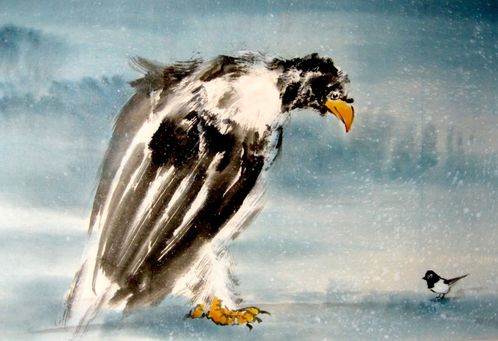By Stan Chan
A Chinese Brush Painting is watercolour art painted with Chinese brushes, ink and water-soluble pigments formulated with gum to bond the pigments to the Xuan paper or silk.
Xuan paper is hand-made available by the sheet in 1ply, 2 ply or 3ply. Like watercolour paper, it comes in different thicknesses. Often people call the Xuan paper "rice paper", but it is not made with rice. Xuan paper is normally made from different plant materials, such as sandalwood, bamboo, hemp, linen, mulberry bark and rice straw. Xuan paper comes in two different kinds, raw and treated. Raw paper is untreated, soft and very absorbent, and is great for doing spontaneous style paintings. Treated Xuan paper is treated with alum and is not absorbent. The colour and ink will not penetrate the size on the surface. Its good for painting detailed works.
Chinese brushes are made of animal hair such as goat, rabbit, weasel, horse etc. The handles are mostly made from bamboo. The brush can be shaped into a fine point for detailed work and spread and split for different brush strokes of wash and effects. Mostly the size of brushes I use is round 1cm - 1.5cm diameter and the bristles are 3.5cm to 6 cm in length for fine line art and small wash work. For bold line art works and bigger washes, the brushs bristles are 2cm diameter and 6cm to 3cm diameter to 10 cm in length. The larger brushes allow the artist to be able to work freely on spontaneous style paintings. The largest brush in my studio is 6 cm diameter by 15 cm in length for larger calligraphy and brush strokes and the smallest brushes are so fine that the tip comes down to a needle point for fine detail work.

The Chinese brushes have the unique capacity to hold much more liquid. This allows for more than one colour to be loaded at one time, so the artist can paint brushstrokes without interruption. Above is a painting of iris which has been done in this way. I charge the brush with light blue and further down the bristle I charge some deeper tone of blue plus at the tip some much darker colour and I turn the brush on the side and paint in one or two strokes. Its worked on raw Xuan paper. The colours will blend together like washes in western water colour. You needed to control the amount of water you hold in your brush, making sure its not too much water, otherwise it will become a big blob of colour and lose the shape of the flower.
Ink stick and Ink stone: ink sticks are usually made from the soot of burned pine and the soot is mixed with glue. This mixture is poured unto a mould and left to dry. Ink stones are natural stone in various shapes with an ink well for holding the ink. Ink is made by grinding the ink stick in a circular direction on an ink stone. I put about two or three teaspoons of water in the ink stone and grind it until the water becomes black. The ink will be ready to work with water and colours.
The Chinese colours are water based and made of plants and minerals, along with glue. The colour in Chinese painting is similar to regular watercolours. The main difference is that Chinese watercolours will not run. They stay on the Xuan paper when I do the stretching process. After I finish a brush painting on Xuan paper, I stretch it on another sheet of Xuan paper. When its all dried, the art work is ready. If I use regular watercolour pigments, I will stretch the paper before I start my painting.

On the painting with a large eagle and a little bird in a snow background I worked with a large wolf hair brush and painted the eagle in limited stokes on raw Xuan paper. I painted with a very large goat hair brush the wash of blue and while its still wet put on some small white drops as snow on the blue background. When it is touch dry, I turn the painting upside down paint more darker blue wash on the other side of the Xuan paper. That will let the snow white drops stand out and blend with the background. This technique only works on the Xuan paper, because its so thin the colours come right through the back. It can not work on my regular water colour papers.
My technique of painting is somehow hard to explain but it would be much clearer to see me working. I show my students a nice clear way of learning and they enjoy my demonstration. In May 2011, I was teaching a Western Watercolour and Chinese Brush Painting workshop for Geyserland Art Group in Rotorua for both beginner and advanced artists. They enjoyed and explored this new approach. The Course Coordinator Miriam reported to me: "Your influence is making its way into several people's work. People are taking greater interest in Chinese art generally, and seeing that they can paint in western styles with oriental materials and vice versa, as well as using simpler, bolder strokes - and so producing more dramatic work.



